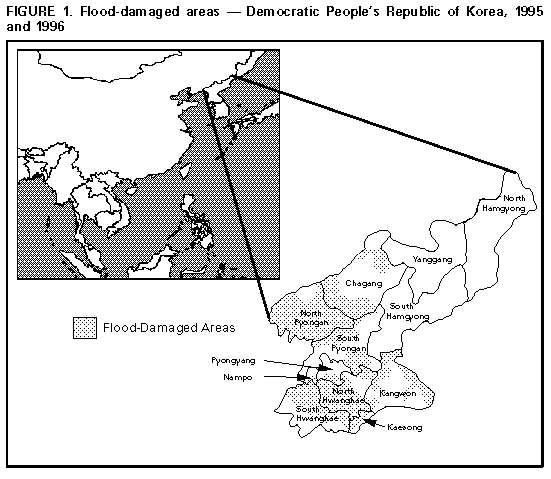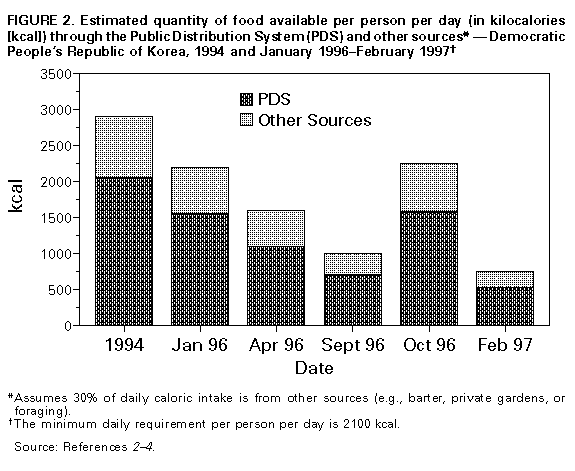 |
|
|
|
|
|
|
| ||||||||||
|
|
|
|
|
|
|
||||
| ||||||||||
|
|
|
|
|
Persons using assistive technology might not be able to fully access information in this file. For assistance, please send e-mail to: mmwrq@cdc.gov. Type 508 Accommodation and the title of the report in the subject line of e-mail. Status of Public Health -- Democratic People's Republic of Korea, April 1997During 1995 and 1996, severe flooding in the Democratic People's Republic of Korea (i.e., North Korea {DPRK} {1990 population: 22 million}) (Figure_1) caused 186 deaths, dislocated approximately 550,000 persons from their homes, and caused damage to an estimated 1.2 million metric tons of crops (12% of total production) (1,2). In combination with systemic economic problems in DPRK, these natural disasters have been associated with reports of a severe, ongoing food shortage and increased risks to public health. To assist in targeting humanitarian aid, in April 1997, the U.S. Agency for International Development's Office of U.S. Foreign Disaster Assistance requested CDC to conduct an onsite assessment of the public health status and needs of the DPRK. This report summarizes findings of the assessment, which indicate a recent substantial decline in the health and nutritional status in DPRK. The onsite assessment was conducted during April 1997 by a CDC epidemiologist. Information in this report is based on interviews with local public health officials; reports prepared by United Nations (UN) agencies; and direct observations in Pyong-yang, North Pyongan, and South Pyongan provinces. Primary data were collected only in North Pyongan province because of constraints on time and independent travel. Based on reports by the UN's Food and Agriculture Organization (FAO) and World Food Program (WFP), from 1984 through 1996, floods, outmoded agricultural techniques, and a lack of fertilizer reduced annual grain production in DPRK from 8.1 million metric tons (MT) to 4.3 million MT, respectively (1,2). Declines in concessional grain sales from other countries have prevented DPRK from compensating for reduced agricultural production with increased food imports and have resulted in a projected food deficit of 2.3 million MT for 1996-1997 (2). Despite international food aid totaling greater than 400,000 MT during 1995-1996, grain allocation through the Public Distribution System (PDS) has declined from a preflood average of 585 g per person per day to 100-150 g per person per day during February-April 1997 (2-4); members of the military, government officials, and hard laborers reportedly receive higher allocations. Children aged less than or equal to 6 years are eligible to attend nursery centers where they are entitled to receive an additional 150 g per day in the form of corn soya blend. However, UN field reports indicate that since March 1997, attendance in nurseries has declined by 40%-80%, children's supplemental feeding has been halted in Chagang province, and the PDS has not provided a general food ration in North and South Hamgyong provinces (R. Soerensen, United Nations Children's Fund {UNICEF}/Pyongyang, and M. Ross, WFP/New York, personal communications, 1997; 4). FAO and WFP estimate that persons in the DPRK supplement food provided by the PDS with an additional 30% of daily caloric intake from other sources (e.g., barter, private gardens, or foraging); however, the combination of food sources does not consistently provide the adult minimum daily caloric requirement of 2100 kilocalories (kcal) (Figure_2) (2). Although DPRK has not permitted comprehensive, objective, anthropometric nutrition surveys, the CDC assessment did obtain weight and height measurements for nine infants in an orphanage in North Pyongan province. Of the nine infants, four were acutely malnourished (weight-for-height greater than 2 standard deviations below the National Center for Health Statistics/CDC/World Health Organization reference median {5}). In April 1997, UNICEF documented evidence of acute malnutrition in four of 18 children aged 2-5 years in a kindergarten in Chagang Province (R. Soerensen, UNICEF/Pyong-yang, personal communication, 1997). Clinical signs of anemia were present in malnourished infants in both North Pyongan and Chagang provinces, although blood samples could not be obtained. On April 8, 1997, the DPRK Ministry of Public Health (MoPH) reported that malnutrition was present in 15.6% (324,000) of all children aged less than 5 years and that 134 of these children had died in 1996 (R. Soerensen, UNICEF/Pyongyang, personal communication, 1997); the MoPH report did not specify the method of data collection or the definition of malnutrition. The flooding destroyed or heavily damaged 298 health facilities and the only oral-rehydration solution factory in DPRK (6). In addition, flood damage and a lack of raw materials have led to a 60% decline in pharmaceutical production since 1995 (4). The CDC assessment included four hospital pharmacies in North and South Pyongan provinces and indicated that only herbal medicines were in supply. The MoPH reported that through 1994, Expanded Program on Immunization (EPI) coverage of 95% had been achieved for children aged less than 5 years. However, since 1995, vaccination programs have not been conducted regularly because of a lack of vaccines (especially for poliomyelitis and tuberculosis), breakdowns in cold-chain equipment, and disruptions in transportation caused by the floods and shortages of fuel (4). The MoPH has reported seven confirmed cases of polio in 1995, six in 1996, and three during January-March 1997 (7). From 1994 to 1996, overall crude mortality for children aged less than 5 years increased from 31 per 1000 to 58 per 1000 (DPRK MoPH briefing, 1997; R. Soerensen, UNICEF/Pyongyang, personal communication, 1997). Although the MoPH did not provide information on specific causes associated with the increased mortality, the MoPH reported that during January-September 1996, the number of cases of diarrhea was 20% higher and the number of cases of acute respiratory infection was 15% higher than the average number of such cases reported since 1992 (6). Reported by: Office of US Foreign Disaster Assistance, US Agency for International Development, Washington, DC. International Emergency and Refugee Health Program, National Center for Environmental Health, CDC. Editorial NoteEditorial Note: The information provided in this report suggests objective and subjective evidence of malnutrition, increases in morbidity and mortality, and failures of the medical and public health infrastructure in DPRK. Despite the occurrence of acute malnutrition and micronutrient deficiencies and food deficits, severe malnutrition may not be highly visible because of at least four factors: 1) limited food stocks have been distributed equitably; 2) food production or availability through non-PDS sources may be higher than estimated; 3) household coping skills have been adequate; and 4) assessments have been conducted in only selected areas, and malnutrition may be less severe or less prevalent in those areas than in other areas (particularly the mountainous northeast region) to which access by international observers has been limited. Since 1960, the primary causes of mortality in DPRK have gradually shifted from those of predominantly infectious etiology to chronic diseases, and the estimated annual crude mortality rate has decreased from 17 per 1000 in 1960 to 6 per 1000 in 1992 (8). The recent increase in infectious disease morbidity reported by MoPH may reflect factors including 1) damage to water/sanitation systems caused by the floods; 2) decreased capacity of both clinical-care and prevention programs; and 3) increased risk secondary to declining nutritional status. The increase in the death rate for children aged less than 5 years probably reflects the effects of these same factors, and the most recent rate of 58 per 1000 compares with a rate in 1995 of 10 per 1000 in the Republic of Korea and a rate of 120-200 per 1000 in most countries in Africa (9). The MoPH reported no cases of polio during 1987-1994 (7); the recent occurrence of cases and the deterioration of the vaccination program suggest a continuing high potential for outbreaks of polio and other vaccine-preventable diseases. Because of the geographic limitation of this assessment and the diminished capacity of surveillance systems to detect diseases of public health importance, high priority should be given to conducting an independent, nationwide health and nutrition survey to obtain more objective data about the health status of the population of DPRK. Further recommendations for immediate action by appropriate UN agencies and nongovernmental organizations have included supplying high-energy milk and micronutrient supplementation for children, continuing general food aid, and restoring essential public health services, especially vaccination and water-chlorination programs. References
Figure_1  Return to top. Figure_2  Return to top. Disclaimer All MMWR HTML versions of articles are electronic conversions from ASCII text into HTML. This conversion may have resulted in character translation or format errors in the HTML version. Users should not rely on this HTML document, but are referred to the electronic PDF version and/or the original MMWR paper copy for the official text, figures, and tables. An original paper copy of this issue can be obtained from the Superintendent of Documents, U.S. Government Printing Office (GPO), Washington, DC 20402-9371; telephone: (202) 512-1800. Contact GPO for current prices. **Questions or messages regarding errors in formatting should be addressed to mmwrq@cdc.gov.Page converted: 09/19/98 |
|||||||||
This page last reviewed 5/2/01
|